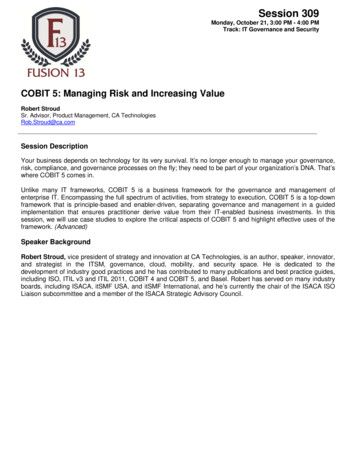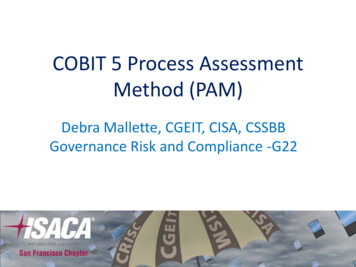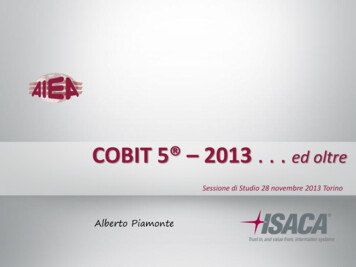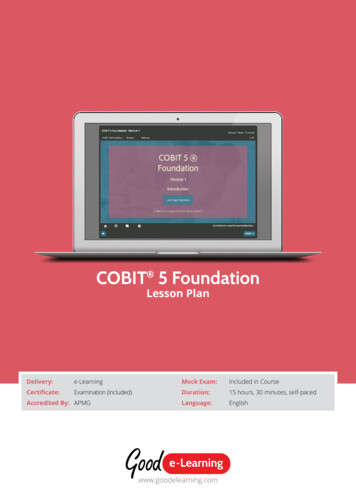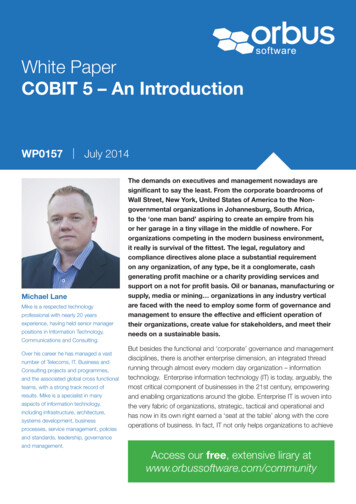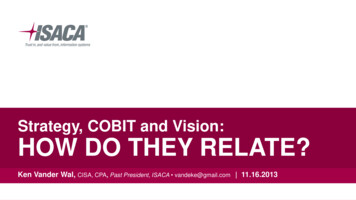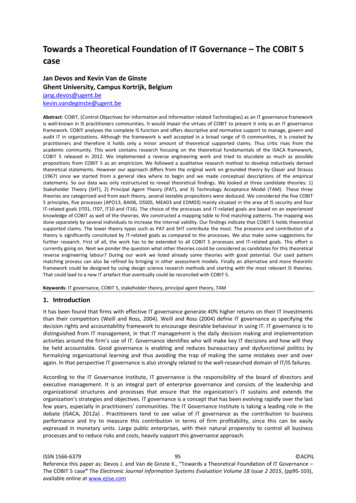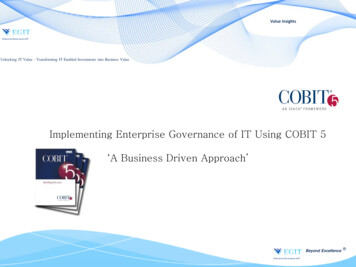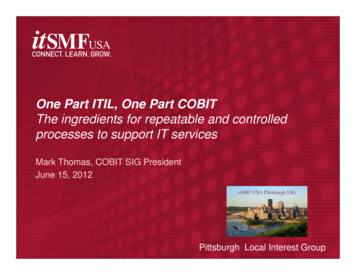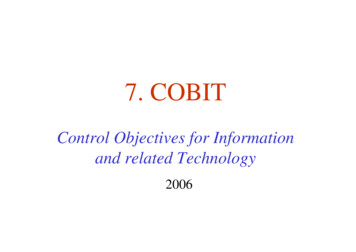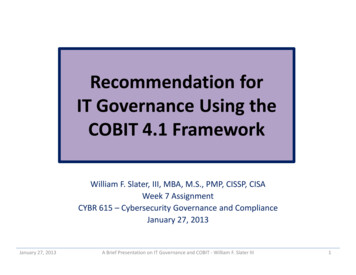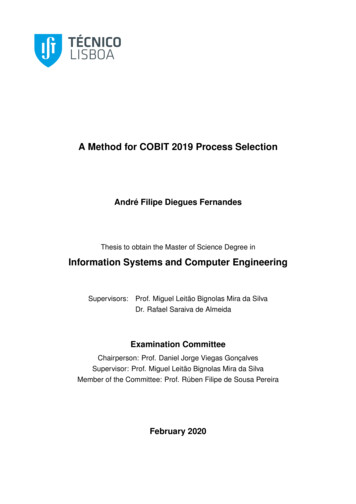
Transcription
A Method for COBIT 2019 Process SelectionAndré Filipe Diegues FernandesThesis to obtain the Master of Science Degree inInformation Systems and Computer EngineeringSupervisors:Prof. Miguel Leitão Bignolas Mira da SilvaDr. Rafael Saraiva de AlmeidaExamination CommitteeChairperson: Prof. Daniel Jorge Viegas GonçalvesSupervisor: Prof. Miguel Leitão Bignolas Mira da SilvaMember of the Committee: Prof. Rúben Filipe de Sousa PereiraFebruary 2020
ii
AcknowledgmentsI would like to take this opportunity to express my gratitude to everyone who has helped me throughoutmy Master’s degree.First, I would like to express my sincere appreciation to my advisor, Professor Miguel Mira da Silva,for his endless support. His valuable knowledge and guidance were essential to the final outcome ofthis dissertation.Secondly, I would like to thank Doctor Rafael Saraiva de Almeida for always being available, and forall his help, patience, motivation, and immense knowledge.I am forever thankful to my sister, mother, and father, Tânia, Fátima, and João, for your patience,trust and unconditional support throughout my academic journey.Finally, thanks to my girlfriend, Chaoying, for supporting me throughout the writing of this thesis andmy life in general.iii
iv
AbstractCOBIT (Control Objectives for Information and Related Technologies) provides a framework that supports enterprises in achieving their objectives in the governance and management of enterprise IT. Thecurrent method for the selection and prioritisation of Management Objectives in COBIT 2019 does notprovide enterprises with the flexibility to customise their Design Factors, which means that it is not possible to adapt the framework to their context. In this research, we propose an alternative method to thecurrent one provided by COBIT 2019, which aims to solve this problem. We use a multicriteria decisionmaking method called the Analytic Hierarchy Process (AHP) in combination with the COBIT 2019 DesignFactors to help organisations establish their priorities for a better implementation of COBIT 2019. In theevaluation step, we conduct a simulation and compare the results from both the current method and ourproposed method against the decision of domain experts.Keywords: Enterprise Governance of IT, COBIT 2019, Goals Cascade, AHP, Design Factors.v
vi
ResumoCOBIT (Control Objectives for Information and Related Technologies) é uma framework que apoia asempresas na concretização dos seus objectivos de governação e gestão das TI. O método actual paraa selecção e prioritização dos Objectivos de Gestão (Management Objectives) no COBIT 2019 nãoproporciona às organizações a flexibilidade necessária para personalizar os seus Factores de Design,o que significa que não é possı́vel adaptar a framework ao seu contexto. Nesta investigação, propomosum método alternativo ao actual fornecido pelo COBIT 2019, que visa resolver este problema. Utilizamos um método de decisão multicritério chamado Analytic Hierarchy Process (AHP) em combinaçãocom os Design Factors do COBIT 2019 para ajudar as organizações a estabelecer as suas prioridadespara uma melhor implementação do COBIT 2019. Na etapa de avaliação, realizamos uma simulação ecomparamos os resultados tanto do método atual (COBIT 2019) como do método proposto em relaçãoà decisão dos especialistas do setor.Keywords: Enterprise Governance of IT, COBIT 2019, Goals Cascade, AHP, Design Factors.vii
viii
ContentsAcknowledgments . . . . . . . . . . . . . . . . . . . . . . . . . . . . . . . . . . . . . . . . . . .iiiAbstract . . . . . . . . . . . . . . . . . . . . . . . . . . . . . . . . . . . . . . . . . . . . . . . . .vResumo . . . . . . . . . . . . . . . . . . . . . . . . . . . . . . . . . . . . . . . . . . . . . . . . .viiList of Tables . . . . . . . . . . . . . . . . . . . . . . . . . . . . . . . . . . . . . . . . . . . . . .xiList of Figures. . . . . . . . . . . . . . . . . . . . . . . . . . . . . . . . . . . . . . . . . . . . .xiiiNomenclature . . . . . . . . . . . . . . . . . . . . . . . . . . . . . . . . . . . . . . . . . . . . . .1Glossary . . . . . . . . . . . . . . . . . . . . . . . . . . . . . . . . . . . . . . . . . . . . . . . .11 Introduction11.1 Research Challenge . . . . . . . . . . . . . . . . . . . . . . . . . . . . . . . . . . . . . . .31.2 Outline of this document . . . . . . . . . . . . . . . . . . . . . . . . . . . . . . . . . . . . .42 Research Methodology53 Theoretical Background73.1 Enterprise Governance of IT . . . . . . . . . . . . . . . . . . . . . . . . . . . . . . . . . .73.1.1 From ITG to EGIT . . . . . . . . . . . . . . . . . . . . . . . . . . . . . . . . . . . .73.1.2 Enterprise Governance of IT Definition . . . . . . . . . . . . . . . . . . . . . . . . .73.1.3 Contingency factors . . . . . . . . . . . . . . . . . . . . . . . . . . . . . . . . . . .83.2 COBIT . . . . . . . . . . . . . . . . . . . . . . . . . . . . . . . . . . . . . . . . . . . . . . .83.2.1 COBIT 5 . . . . . . . . . . . . . . . . . . . . . . . . . . . . . . . . . . . . . . . . . .83.2.2 Goals Cascade . . . . . . . . . . . . . . . . . . . . . . . . . . . . . . . . . . . . . .93.2.3 From COBIT 5 to COBIT 2019 . . . . . . . . . . . . . . . . . . . . . . . . . . . . .103.2.4 COBIT 2019 . . . . . . . . . . . . . . . . . . . . . . . . . . . . . . . . . . . . . . .103.3 Multi-Criteria Decision Making . . . . . . . . . . . . . . . . . . . . . . . . . . . . . . . . . .133.3.1 Analytic hierarchy process . . . . . . . . . . . . . . . . . . . . . . . . . . . . . . . .133.3.2 Summary . . . . . . . . . . . . . . . . . . . . . . . . . . . . . . . . . . . . . . . . .174 Related Work194.1 Enterprise Governance of IT . . . . . . . . . . . . . . . . . . . . . . . . . . . . . . . . . .194.1.1 Impact of Enterprise Governance . . . . . . . . . . . . . . . . . . . . . . . . . . . .194.2 COBIT 5 Prioritization Problem . . . . . . . . . . . . . . . . . . . . . . . . . . . . . . . . .20ix
4.2.1 AHP with Balanced Scorecard (BSC) . . . . . . . . . . . . . . . . . . . . . . . . .244.3 AHP to prioritise COBIT 5 processes. . . . . . . . . . . . . . . . . . . . . . . . . . . . . .265 Proposal295.1 Objectives . . . . . . . . . . . . . . . . . . . . . . . . . . . . . . . . . . . . . . . . . . . . .295.2 Proposal Description . . . . . . . . . . . . . . . . . . . . . . . . . . . . . . . . . . . . . . .295.2.1 Step 1: Stakeholders’ Needs Cascade to Enterprise Goals (manual step). . . . . .345.2.2 Step 2: Enterprise Goals prioritisation (manual step). . . . . . . . . . . . . . . .345.2.3 Step 3: Enterprise Goals Cascade to Alignment Goals (automatic step). . . . . . .345.2.4 Step 4: Alignment Goals prioritization (automatic step). . . . . . . . . . . . . . . .345.2.5 Step 5: Alignment Goals Cascade to Management Objectives (automatic step). . .345.2.6 Step 7: Run AHP (automatic step). . . . . . . . . . . . . . . . . . . . . . . . . . . .356 Demonstration376.1 Step 1: Stakeholders’ Needs Cascade to Enterprise Goals. . . . . . . . . . . . . . . . . .376.2 Step 2: Enterprise Goals prioritisation. . . . . . . . . . . . . . . . . . . . . . . . . . . . . .386.3 Step 3. Enterprise Goals Cascade to Alignment Goals. . . . . . . . . . . . . . . . . . .386.4 Step 4: Alignment Goals prioritisation. . . . . . . . . . . . . . . . . . . . . . . . . . . . . .386.5 Step5: Alignment Goals Cascade to Management Objectives. . . . . . . . . . . . . . . . .386.6 Step 6: Comparison of Processes . . . . . . . . . . . . . . . . . . . . . . . . . . . . . . .396.7 Step 7: Run AHP . . . . . . . . . . . . . . . . . . . . . . . . . . . . . . . . . . . . . . . . .396.8 Summary . . . . . . . . . . . . . . . . . . . . . . . . . . . . . . . . . . . . . . . . . . . . .397 Evaluation437.1 First round of interviews . . . . . . . . . . . . . . . . . . . . . . . . . . . . . . . . . . . . .437.2 Second round of interviews . . . . . . . . . . . . . . . . . . . . . . . . . . . . . . . . . . .447.3 Analysis of interviews . . . . . . . . . . . . . . . . . . . . . . . . . . . . . . . . . . . . . .457.4 Evaluation of requirements . . . . . . . . . . . . . . . . . . . . . . . . . . . . . . . . . . .488 Conclusion538.1 Achievements . . . . . . . . . . . . . . . . . . . . . . . . . . . . . . . . . . . . . . . . . . .538.2 Limitations. . . . . . . . . . . . . . . . . . . . . . . . . . . . . . . . . . . . . . . . . . . .548.3 Future Work . . . . . . . . . . . . . . . . . . . . . . . . . . . . . . . . . . . . . . . . . . . .54Bibliography55A Figures59x
List of Tables3.1 Comparison between different MCDMs [17] . . . . . . . . . . . . . . . . . . . . . . . . . .154.1 Each Measure and mean of the BSC attribute [23] . . . . . . . . . . . . . . . . . . . . . .254.2 The matrix of pairwise comparisons and the sum of the columns [23] . . . . . . . . . . . .254.3 The weight of each BSC attribute [23] . . . . . . . . . . . . . . . . . . . . . . . . . . . . .254.4 The rank of each Criteria [20] . . . . . . . . . . . . . . . . . . . . . . . . . . . . . . . . . .284.5 Final rank of each Process . . . . . . . . . . . . . . . . . . . . . . . . . . . . . . . . . . .285.1 Conversion table of relationships to the Saaty scale. . . . . . . . . . . . . . . . . . . . .315.2 Comparison between Alignment Goal 04 and Alignment Goal 05 . . . . . . . . . . . . . .315.3 Comparison between Enterprise Goal 04 and Enterprise Goal 07 . . . . . . . . . . . . . .345.4 Comparison between Alignment Goal 04 and Alignment Goal 10 . . . . . . . . . . . . . .347.1 Comparison between Alignment Goal 04 and Alignment Goal 10 . . . . . . . . . . . . . .44xi
xii
List of Figures2.1 DSRM process with the research context adapted from [29] . . . . . . . . . . . . . . . . .63.1 Contingency factors [25] . . . . . . . . . . . . . . . . . . . . . . . . . . . . . . . . . . . . .93.2 COBIT historical timeline [38] . . . . . . . . . . . . . . . . . . . . . . . . . . . . . . . . . .93.3 Relation between Enterprise Goals and IT-Related Goals [11] Appendix (A.1) . . . . . . .113.4 Design Guide COBIT 2019 [15] . . . . . . . . . . . . . . . . . . . . . . . . . . . . . . . . .123.5 Relation between Enterprise Goals and Alignment Goals [15] . . . . . . . . . . . . . . . .133.6 Relation between Alignment Goals and Management Objectives [15] (Appendix A.2) . . .143.7 Design Factors [15] . . . . . . . . . . . . . . . . . . . . . . . . . . . . . . . . . . . . . . . .153.8 The fundamental table of Saaty scale [46] . . . . . . . . . . . . . . . . . . . . . . . . . . .163.9 The Random Index . . . . . . . . . . . . . . . . . . . . . . . . . . . . . . . . . . . . . . . .173.10 AHP simple example . . . . . . . . . . . . . . . . . . . . . . . . . . . . . . . . . . . . . . .184.1 Comparison of the two sets of mapping tables [24] . . . . . . . . . . . . . . . . . . . . . .214.2 Results of Research Question 1 [24] . . . . . . . . . . . . . . . . . . . . . . . . . . . . . .224.3 Results of Research Question 2 [24] . . . . . . . . . . . . . . . . . . . . . . . . . . . . . .224.4 COBIT 5 process weight range after goals cascade application (N 2500) [24] . . . . . . .234.5 COBIT 5 process ranking range after goals cascade application (N 2500)[24] . . . . . . .234.6 BSC used by Lee et al. [23] from COBIT 5 [37] . . . . . . . . . . . . . . . . . . . . . . . .244.7 Priority of IT objectives obtained by applying the paper methodology [23]. . . . . . . . .264.8 Method presented in Almeida et al. research [20] . . . . . . . . . . . . . . . . . . . . . . .274.9 AHP structure [20] . . . . . . . . . . . . . . . . . . . . . . . . . . . . . . . . . . . . . . . .275.1 Relation between Enterprise Goals and Alignment Goals [15] . . . . . . . . . . . . . . . .305.2 Relation between Alignment Goals and Management Objectives [15] (Appendix A.2) . . .325.3 Representation of COBIT 2019 method and AHP method . . . . . . . . . . . . . . . . . .335.4 Comparison between all the Management Objectives. . . . . . . . . . . . . . . . . . . .355.5 Result of the example presented . . . . . . . . . . . . . . . . . . . . . . . . . . . . . . . .356.1 List of Enterprise Goals . . . . . . . . . . . . . . . . . . . . . . . . . . . . . . . . . . . . .386.2 Comparison of Enterprise Goals . . . . . . . . . . . . . . . . . . . . . . . . . . . . . . . .386.3 Mapping Table between Enterprise Goals and Alignment Goals . . . . . . . . . . . . . . .39xiii
6.4 Mapping Table between Alignment Goals and Management Objectives [15] (Appendix A.3) 406.5 Comparison of Management Objectives (AG11) . . . . . . . . . . . . . . . . . . . . . . . .406.6 Comparison of Management Objectives (AG01) . . . . . . . . . . . . . . . . . . . . . . . .416.7 Results of the practical example . . . . . . . . . . . . . . . . . . . . . . . . . . . . . . . .417.1 List of the interviewee and the two list produced by the proposed method and COBIT 2019method . . . . . . . . . . . . . . . . . . . . . . . . . . . . . . . . . . . . . . . . . . . . . .457.2 Summary of the first interview . . . . . . . . . . . . . . . . . . . . . . . . . . . . . . . . . .467.3 Summary of the second interview . . . . . . . . . . . . . . . . . . . . . . . . . . . . . . . .477.4 Summary of third interview (Appendix A.4). . . . . . . . . . . . . . . . . . . . . . . . . .487.5 Summary of fourth interview . . . . . . . . . . . . . . . . . . . . . . . . . . . . . . . . . . .497.6 Summary of fifth interview . . . . . . . . . . . . . . . . . . . . . . . . . . . . . . . . . . . .497.7 Mapping between Management Objectives and Design Factor 1 criteria . . . . . . . . . .50A.1 Relation between Enterprise Goals and IT-Related Goals [11] . . . . . . . . . . . . . . . .60A.2 Relation between Alignment Goals and Management Objectives [15] . . . . . . . . . . . .61A.3 Mapping Table between Alignment Goals and Management Objectives . . . . . . . . . . .62A.4 Summary of third interview . . . . . . . . . . . . . . . . . . . . . . . . . . . . . . . . . . .63xiv
Chapter 1IntroductionThe issues, opportunities, and challenges of effectively managing and governing an organisation’s Information Technology (IT) investments, resources, and significant initiatives have become a major concernof enterprises on a global basis [1]. Long-term success in organisations requires a secure connectionbetween business and IT, to maximise benefits and reduce the uncertainties of IT projects [2].However, due to the focus on “IT” in the naming of the concept, the IT Governance discussion mainlystayed a discussion within the IT area [3]. This situation initiated a shift in the naming of the conceptfrom “IT Governance” to “Enterprise Governance of IT” [4].Enterprise Governance of IT (EGIT) can be defined as ”an integral part of corporate governanceand addresses the definition and implementation of processes, structures and relational mechanismsin the organisation that enable both business and Information Technology (IT) people to execute theirresponsibilities in support of business/IT alignment and the creation of business value from IT-enabledbusiness investments” [5]. EGIT can be deployed using a mixture of structure, processes and relationalmechanisms [6] that encourage behaviours consistent with the organisation’s mission, strategy, values,norms, and culture [7].Enterprises are increasingly making tangible and intangible investments in improving their EGIT [4].In support of this, enterprises are drawing upon the practical relevance of generally accepted goodpractice frameworks such as COBIT, ITIL and ISO 27000 [4]. In this thesis, we decided to analyseCOBIT since researchers have agreed that it is among the most popular, valuable frameworks andframeworks/standards currently being adopted [15,21]. Several researches have also shown that COBITis widely adopted by organisations in practice [6, 8, 9].COBIT presents a framework to support enterprises in accomplishing their goals in the governanceand management of enterprise IT [10]. According to ISACA, ‘COBIT 5 provides a comprehensive framework that assists enterprises to achieve their objectives for the governance and management of enterprise IT. COBIT 5 enables IT to be governed and managed holistically for the whole enterprise, taking inthe full end-to-end business and IT functional areas of responsibility, considering the IT-related interestsof internal and external stakeholders’ [11].1
COBIT 5 introduces a valuable tool, the Goals Cascade, which translates stakeholder needs into anorganisation’s actionable strategy [10]. This method constitutes the core entry point for the COBIT 5process improvement [12]. In COBIT 5 there is an explicit assumption that organisations should start byanalysing their business/IT alignment state through the definition of enterprise goals, linking those goalsto IT-related goals, and subsequently to the IT processes [13, 14].In 2018, ISACA released COBIT 2019, the first update of COBIT after almost seven years. One ofthe major differences between COBIT 5 and COBIT 2019 is related to the Goals Cascade mechanism.In the new version, the Goals Cascade is not the core entry point, but just part of a broader mechanism.In COBIT 2019, different Design Factors were introduced, namely Enterprise Strategy, EnterpriseGoals, Risk Profile, Enterprise Size, Threat Landscape, Compliance Requirements, Role of IT, SourcingModel for IT, IT Implementation Methods and Technology Adoption Strategy.These Design Factors influence the design of an enterprise’s governance system, representing whatan enterprise must consider in tailoring governance systems to realise their most IT value[15].A tailored governance system based on COBIT is a system that has taken the generic contents ofCOBIT and has assigned specific priorities and target capability levels to the governance and management components based on the enterprise’s context and design factor values [15].Taking an evolutionary analysis of COBIT, while in COBIT 5 the Goals Cascade was the sole mechanism for selecting processes (currently called Management Objectives), in COBIT 2019, it is only oneout of ten combined ”factors” in making that selection. Therefore, in order to have an ordered list of Management Objectives, each organisation must make an individual analysis of each Design Factor. Forthis purpose, ISACA provides a toolkit with an evaluation model to be completed by the organisation. Atthe end of the assessment, a prioritised list of Management Objectives is suggested to the user.In this research, the method suggested by ISACA to choose Management Objectives was studied.This method has a toolkit, also provided by ISACA, which is the practical implementation of the methodin question. To better understand this method, different scenarios were simulated during this research.The authors concluded that the suggested method has some flaws that may influence the choice ofManagement Objectives, such as lack of customisation and rigidity in the pre-defined criteria. As a result,instead of having a method that adapts to the organisation, this new method requires the organisationto adjust the tool.In this research, we propose an alternative method to help organisations achieve better results whenselecting the Management Objectives. Multi-Criteria Decision Making (MCDM) methods support decision making in the presence of multiple, usually conflicting, criteria [16]. Based on the literature reviewcarried out by Velasquez and Hester [17] we concluded that the Analytical Hierarchy Process (AHP) andMulti-Attribute Utility Theory (MAUT ) are the most popular MCDMs.AHP is a powerful and flexible multi-criteria decision-making tool for dealing with complex problemswhere both qualitative and quantitative aspects need to be considered [18]. MAUT is “a more rigorousmethodology for how to incorporate risk preferences and uncertainty into multi-criteria decision supportmethods” [19], but Velasquez and Hester also recognise that MAUT needs a lot of input and preferencesto be precise [17].2
AHP has some advantages and disadvantages to consider. The ease of use of the AHP is a recognisable strength. The AHP takes as its premise the idea that it is our concept of reality that is crucial andnot our conventional representations of that reality by means such as statistics. With the AHP, practitioners can assign numerical values to what are essentially abstract concepts and then deduce from thesevalues decisions to apply in the global framework. [20, 21]. This simplicity is crucial, as more complexmethods require a more significant learning effort, something that does not fit in with this problem.Therefore, in this research, we propose to use the AHP to help organisations establish the prioritiesfor the COBIT 2019 process implementation. AHP was developed in the 1970s by Saaty and has sincebeen extensively studied, and is currently used in decision making for complex scenarios, where peoplework together to make decisions when human perceptions, judgments, and consequences have longterm repercussions [22].The results of this research are demonstrated using Design Factor (DF) 2 (COBIT 5 Goals Cascade)since the transition from the old Goals Cascade to the new DF2 is minimal. It also makes it considerablymore accessible to find experts in the field willing to collaborate. However, this method can be appliedto any of the Design Factors without losing any of the advantages that will be referenced throughout thisdocument.To evaluate the proposed method, a series of interviews were conducted with experts. During theseinterviews, each specialist compared their answers with those obtained using the method proposed byCOBIT 2019 and the method proposed in this research.1.1Research ChallengeCOBIT 2019 introduced a new method that attempts to solve the problems of COBIT 5 discussed inthe literature [20, 23, 24]. During our research, however, we discovered that this method exhibits somemajor flaws which limit its adaptability and usability. These problems are summarised in this chapter.COBIT 5 Goals Cascade is a method to translate the enterprise goals into specific processes. However, this method had several problems that were identified by different authors such as Lee et al.,Almeida et al. and Steuperaert [20, 23, 24].These publications are detailed in Chapter 4 (Related Work).COBIT 2019 defines ten different Design Factors to be selected, which are factors that can influencethe design of an enterprise’s governance system and position it for success in the use of Information &Technology [15].In COBIT 2019, a new method is proposed to select and prioritise specific design factors to beconsidered for an enterprise’s customised governance program [15]. This new method aims to mitigatethe problems of the COBIT 5 Goals Cascade.COBIT 2019 claims that it is a tailored governance solution that every enterprise should adopt as its”governance system for enterprise I&T”, or ”governance system” for short [15]. However, this claim isnot entirely fulfilled due to the following problems with the method: The addition or removal of Design Factors is not possible in this method, which limits the set ofpossible Design Factors that can be selected by an organisation. These Design Factors are por3
trayed in the literature as Contingency Factors, which are covered in the Theoretical Backgroundand Related Work chapters. In these chapters, it is demonstrated that a limited and non-modifiableset can be a limitation for the method. Each Design Factor has its own set of evaluation parameters that are impossible to be modified,added or deleted. Therefore, customisation in the evaluation methods of the Design Factors is notpossible. Due to the absence of customisation possibilities, this process cannot be adapted to the particular context of an organisation or improved based on the experiences and knowledge of experts.Therefore, its potential is limited. There is a lack of theoretical evidence to support this method, as no concrete mathematical formulas are presented in the Design Guide Research book [15] to explain its underlying mechanisms.There is limited scientific literature that supports the problems identified by the authors, given thatthis new version of COBIT was published very recently and thus the number of publications on the topicis limited. Some researchers [25] have shown that there are several factors (Contingency Factors) thatinfluence the correct implementation of EGIT (e.g. Industry and Maturity). However, in the methodpresented by COBIT, it is not possible to add or remove any of these factors, which makes this methodnot adaptable to different organisations, thus limiting its performance.To summarise, we may conclude that COBIT 2019 method is inflexible and lacks theoretical evidencefor the selection and prioritisation of Management Objectives. Therefore, its utility in practice is limitedand is prone to misleading results.1.2Outline of this documentThis work is organised as follows. In Chapter 2, the research methodology used is described. InChapter 3, some background information related to the topics of this thesis is laid out. In Chapter4, works by other researchers are stated. In Chapter 5, the proposed solution is explained, and thedemonstration is made in Chapter 6. In Chapter 7, a series of simulations were conducted to comparethe experts’ answers against the results of COBIT 2019 and that of the proposed method. In Chapter 7,a description is made on how we intend to communicate our research. Finally, a concluding remark ismade in Chapter 9, which summarises the research, highlighting what was achieved in this research aswell as its limitations4
Chapter 2Research MethodologyDesign Science Research Methodology (DSRM) is the research methodology adopted in this research.Design science creates and evaluates IT artifacts intended to solve identified organisational problems[26]. It requires a rigorous process to design artifacts to solve problems, to make research contributions,to evaluate the designs, and to communicate the results to suitable audiences [27]. The goal of designscience is to create and evaluate IT artifacts intended to solve identified organisational problems [26].IT artifacts can be constructs (vocabulary and symbols), models (abstractions and representations),methods (algorithms and practices) or instantiations (implemented and prototype systems) [26]: Constructs provide the language in which problems and solutions are defined and communicated[27]. Models use constructs to represent a real-world situation - the design problem and its solutionspace [28] Methods define processes. They guide how to solve problems, that is, how to search the solutionspace [26]. Instantiations show that constructs, models, or methods can be implemented in a working system.They demonstrate feasibility, enabling accurate assessment of an artifact’s suitability to its intendedpurpose [26].The DSRM process is based on a six steps approach, summarized in Figure 2.1 [26]:1. Problem identification and motivation: The primary goal is to come up with a well-definedproblem that can justify the value of the solution and motivate the investigator to conduct theresearch to look for a possible solution.2. Defining the objectives for a solution: Identification of the quantitative or qualitative objectivesof a solution from the problem definition and knowledge of the state of the problem and possiblesolutions5
Figure 2.1: DSRM process with the research context adapted from [29]3. Design and development: Decision on the artifact’s desired functionality and architecture followed by its construction. A design research artifact can be any created object embedded withresearch contributions.4. Demonstration: Demonstrate the application of the artifact to solve one or more cases of theproblem. cases of the problem.5. Evaluation: Observation and measurement of how well an artifact supports a solution. to theproblem in order to compare the results observed from of the artifact in the demonstration.6. Communication: Communication of the problem and its importance, the artifact, its utility andnovelty, the rigour of its design and its effectiveness to researchers and other relevant audiences.In summary, the guiding principles, practice rules, and a process of DSR for artifact development andartifact evaluation are used to conduct this research.6
Chapter 3Theoretical BackgroundIn this chapter, we present a theoretical background on the topics related to our research.3.1Enterprise Governance of ITIn this section we provide a context to Enterprise Governance of IT3.1.1From ITG to EGITThe modern concepts of EGIT are a legacy from the late nineties’ concepts on IT Governance (ITG),where the first mentions started to appear both in academic and professional literature [30]. Theseorigins led to some definitions of ITG, such as: “IT governance is the organisational capacity exercisedby the board, executive management and IT management to control the formulation and implementationof IT strategy and in this way ensure the fusion of business and IT” [31]. Even though some conceptsthat stand now may have emerged only in the late nineties, it should, however, be noted that many ofthe underlying elements, such as business/IT alignment, has attracted attention many years before that[30]. Due to the focus on “IT” in the naming of the concept, the ITG debate mostly remained a discussionwithin the IT area [32]. However, it is clear that business value from IT investments cannot be achievedsolely by IT, but will always be produced on the business side. This situation raised the issue that theinvolvement of business is critical for ITG and initiated a shift in the definition of ITG towards EnterpriseGovernance of IT (EGIT) [32].3.1.2Enterprise Governance of IT DefinitionIt is widely accepted that organizations depend more and more on IT [33]. However, IT projects stillsuffer from recurring costs, time
COBIT since researchers have agreed that it is among the most popular, valuable frameworks and frameworks/standards currently being adopted [15,21]. Several researches have also shown that COBIT is widely adopted by organisations in practice [6,8,9]. COBIT presents a framework to support enterprises in accomplishing their goals in the governance
